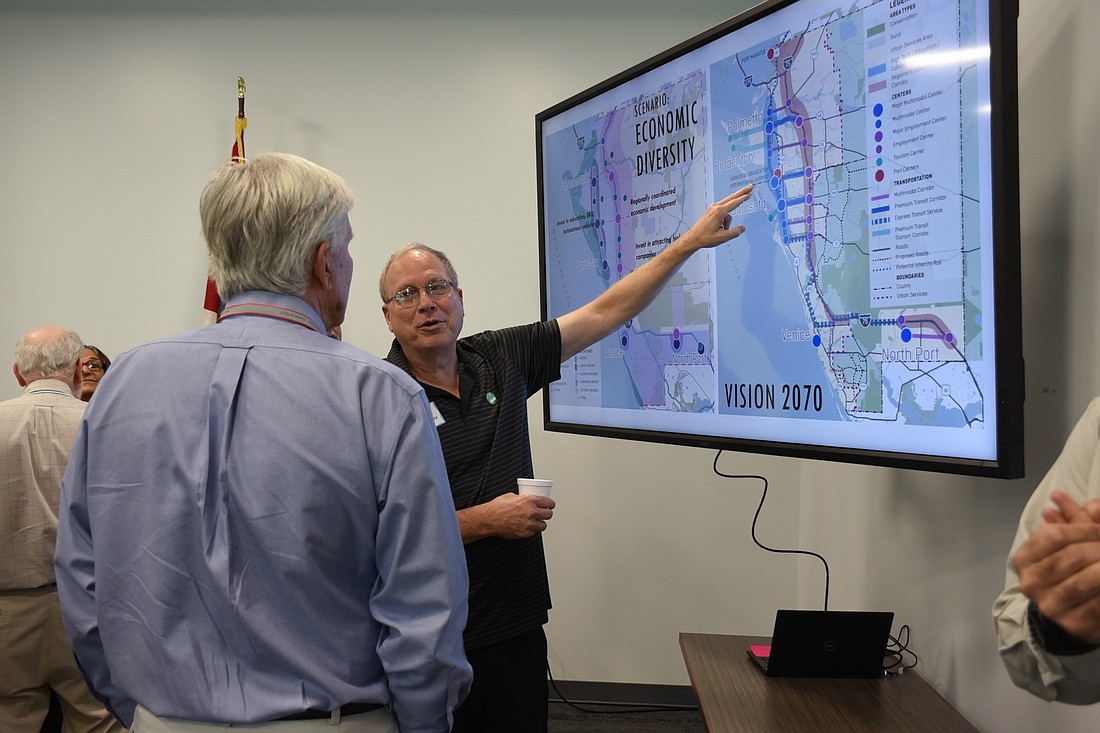- April 25, 2024
-
-
Loading

Loading

The Sarasota-Manatee region of 2070 will be built around two major parallel corridors, U.S. 41 and Interstate 75 — the former a hub of high-tech, education and cultural amenities, the latter a place where regional employment centers are concentrated.
East-west roads including University Parkway, Fruitville Road and Stickney Point Road will link the two, transforming from car-centric designs to ones that emphasize multimodal and public transportation.
Express public transit service will connect the growing southern population centers of Venice and North Port to the more central parts of Sarasota County. Rail service will travel between Port Manatee, Palmetto, Bradenton and the city of Sarasota. Public transit will also help connect the mainland to islands including Lido Key, with a specific emphasis on serving tourists.
This is the vision the Sarasota-Manatee Metropolitan Planning Organization outlined at its Feb. 24 Community Transforum event. The MPO, a regional transportation body, is in the process of updating its long-range transportation plan, which outlines projects the organization supports investment in during the next 25 years.
The Transforum was one of the early steps toward finalizing that plan; between now and this fall, the organization is attempting to produce both a vision and specific project priorities with robust community buy-in.
Corinne Tucker, the MPO’s public involvement coordinator, said there wasn’t necessarily much that came as a surprise when staff put together a “2070 Vision” that attempted to mirror public input. That’s because the organization has been working since the beginning of 2019 to reach out to people in person and online to learn what they want to see the community look like in the future.
Tucker said the vision was designed to balance different things the community has indicated it wanted. That includes things explicitly connected to transportation, such as access to businesses and services and the availability of different modes of transportation. It also included environmental sensitivity and economic diversity in the form of jobs and affordable housing.
Sometimes, Tucker said, the advice the public provided was conflicting. In a conceptual plan, survey results indicated the most popular proposal was the construction of no new roads — but that was also the least popular proposal. As a result, the organization sought an opportunity to find a balance in response to the polarization: The final 2070 Vision includes no new roads built beyond the existing urban services boundary.
Producing a vision is one thing, but how does the MPO actually get local governments and the state to ensure transportation growth is in line with that vision? For one, projects identified in the long-range transportation plan have an advantage when municipalities seek funding from the MPO and the state.
But the organization isn’t trying to dictate the growth of the cities and counties within the region. Tucker said the MPO works closely with both staff and elected officials in local jurisdictions to try to make sure everyone’s goals are aligned. That’s another reason why citizen engagement is important, too.
“This is their vision,” Tucker said. “Everything that gets produced or gets finalized is based on what the community, elected officials and technical professionals have told us.”
Colleen McGue, the city of Sarasota’s chief transportation planner, said it was fortunate that the MPO’s long-range planning process was happening as the city is producing its own transportation master plan. McGue believes many of the people engaged with the city’s planning process are also sharing their thoughts with the MPO, which is leading to ideologically similar plans at the local and regional level.
Having complementary plans isn’t only convenient in a theoretical sense, either. McGue believes the coordination with the MPO will make it easier for the city to get money for the transportation priorities it has identified.
“Because our performance measures we use to suggest these projects are almost completely aligned with the MPO’s performance measures, we anticipate these projects would be competitive for funding,” McGue said.
Although the MPO has produced a long-term vision, the planning process is far from over. The organization is still seeking input on the 2070 Vision. The next Transforum, scheduled for April 20, will focus specifically on how to build out the regional corridors the MPO has identified. The organization will continue to develop supporting documentation before actually finalizing the adoption of the long-range transportation plan this fall.
Both 2045 and 2070 can feel like a long way away, but Tucker stressed the value of getting involved in the planning process — particularly if residents feel like they have no control over transportation decision-making in Sarasota.
“This plan is an opportunity for them to see and have a hand in how their region and their home grows and develops,” Tucker said.